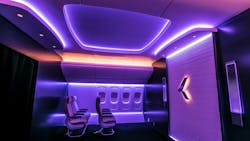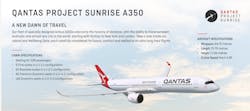Aircraft Cabin Lighting Technology and Trends
In line with aircraft technology in general, aircraft lighting solutions have been upgraded over the years to cater to the evolving needs of passengers and operators. This has been the case in recent times, for example, for the increasing transition to LED lighting solutions. Future solutions will be indeed increasingly compact and energy saving. In this feature we have reached out to industry experts to assess the state of the art of aircraft lighting systems.
Internal vs. External Lights
Internal and external lights perform the same basic function, but external lights need to be much more robust, according to Eric Dahlinger, business development at PWI. “Withstanding the environmental challenges on the exterior of an aircraft include not only rain, but winds, fog, sand, dust and sometimes in combination”, he says. “External lights may also be subject to additional vibration and temperature extremes that internal lights do not, as well as the ability to accept a level of impact not required inside the passenger cabin. This affects the light covering or lens as well as mounting the light to the aircraft.”
PWI has recently launched its Ice Light Window, which is designed for almost a dozen King Air aircraft, to improve ice detection as well as enhancing the range of view around the aircraft. “We know that the ice light window of a King Air can be prone to damage from the existing bulbs. Our new Ice Light Window is a quick and easy replacement for damaged windows,” says Robi Lorik, President and CEO of PWI. “This Ice Light Window ensures one is seen by others while improving the range of view around the aircraft. Warped ice light windows can sometimes be a hazard for a pilot and even other aircraft.”
For flight safety and usage, all aircraft lighting must meet rigorous aerospace grade requirements, observes Matt Opisso, director, business development & strategy at Collins Aerospace. “External lights are designed with a focus on robust components to withstand the many elements of weather conditions and the environment and meet critical specifications to provide safety and functional use to pilots”, he says. “Light lensing and metal bracketry are essential focusses for installation because they maximize the functionality and lighting output.”
Interior lights have functional use within the cockpit and more flexibility for the cabin, according to Opisso. “The cabin lighting for commercial aircraft focuses more on artistic effects, installation locations, color schemes for different flight modes, e.g., boarding or mealtime, and support aesthetic appeal for passenger experience and comfort,” he says.
For both external and internal lighting products, the Federal Aviation Administration (FAA) has done a thorough job of establishing testing, says Dahlinger. “Passing these performance tests help earn PMA and/or STC approvals. These approvals are welcomed by private aircraft owners as well as charter and special missions’ operators,” he says.
LED Lights
Opisso observes that, currently, many new production aircraft are equipped with LED lights. “The benefits and safety of LED lights compared to other technologies is now well known and accepted by the aerospace marketplace,” he says. “With aircraft LED lighting systems in existence for 20+ years, there is an ongoing demand to upgrade older lighting systems from early generation LEDs, fluorescents, or other technologies.”
Today LED cabin lights are also standard equipment in general aviation business jets and high-end turboprops, according to Dahlinger. “External LEDs for beacons, navigation lights, and strobes are also a standard. eVTOL and other electrically powered aircraft use LEDs due to their very low power draw and extremely long life,” he says. “As proven LED technology matures, virtually all aircraft will apply LEDs, inside and out. Today, older aircraft can take advantage of LED upgrades to common fluorescent cabin lighting. External lights, whether halogen or incandescent, can also be upgraded with long life, low power, and low heat LED replacements.”
With LED efficiency, size, and output significantly advanced, there are many benefits to an operator by simply replacing the lighting within the aircraft, according to Opisso. “The colour gamut and quality (colour rendering index) on newer generation LEDs has also provided much more opportunity for creativity and performance enhancements. There are many functional benefits, e.g., power, weight, and aesthetic benefits that can be realized with LED lighting,” he says.
Research and Development
According to Opisso, LEDs and lighting elements continue to advance and move towards smaller, more efficient and powerful LEDs that offer a variety of benefits. “Using highly efficient LEDs with advanced lensing continues to be a focus to maximize the performance of the light. By utilizing advanced LEDs, combined with efficient power supply technology and lighting controls, there are more ways to find energy savings,” says Opisso.
Energy savings are indeed at the heart of LED technology, according to Dahlinger. “While emitting the same amount, or more, light than bulbs, LEDs are solid state and draw very little power. The appealing benefit to owners and operators is the ability to reuse that saved power for other onboard uses such as USB portable device chargers, special missions — medical transport, government/military or firefighting — equipment, food and beverage or cabin entertainment,” he says.
LED technology is trending towards mini and micro sized elements, observes Dahlinger. “These smaller light elements can create higher resolution displays which feature better color saturation. LED manufacturing is improving as well, creating batches of LED elements that are much closer to the design specification,” he says. “In broader terms, LED use in aviation is expanding from a simple spotlight role into more of a screen or panel role. Cabin designers are looking to create complete environments that allow for still and video content, mood-setting lighting and branding images and messaging.”
Having control elements and more focused lighting that have less power requirements provide a direct benefit to the aircraft systems, highlights Opisso. “Smart power management controls are now able to improve the use and functional benefit of lighting systems to put light where it is needed and when, i.e., suite mealtime lighting. Usage of advanced LED lights along with enhanced control offer a significant opportunity to aircraft operators,” he concludes.





